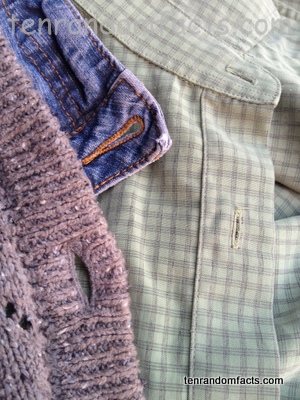Buttonholes are relatively new in comparison to its button partner.
- Buttonholes are a slit or hole in fabric that can hold a button, and normally as a result, hold two pieces of fabric together.
- The edges of the hole designed for buttons are generally stitched over to prevent unravelling of the fabric and to limit wear on the hole edge, and this is done by sewing machine or hand, and the latter method typically uses a stitch called ‘buttonhole stitch’.
- Many traditional garments for men have buttonholes located on the left hand side, while women have them on the right, and there are a number of speculations as to why, with one being that it was due to the slits needing to face the right way on women’s clothes, so that their maids could do up their buttons more easily, while men did their own buttons themselves.
- A button is secured in a buttonhole by sliding the side of the button into the back of the hole and pulling through to the front on one side, and then sliding the other side of the fabric edge behind the button so that the button sits in front of the hole.
- The French word ’boutonnière’ means ‘buttonhole’, and both terms are used for flower/s that are typically inserted into a slit that usually looks the same as those used for buttons, located on the lapel of a jacket or coat.
- Buttonholes are most often found on clothing items like jackets, shirts and coats, but they are also used on pants, and they are usually just long enough to comfortably fit the appropriate button through the slit.
- Button loops were originally used before buttonholes, though they serve a similar purpose, but holes, rather than loops are now more commonly used on clothing.
- In the 1200s in Germany, Europe, practical buttonholes were first recorded, although Persians may have invented the idea, and the 1400s saw much more widespread use of them across Europe, primarily due to the increased use of buttons themselves.
- Buttonholes generally sit horizontally, especially on jackets, as vertical slits allow for the button to slip and unbutton more easily, while the horizontal ones allow for more flexibility in fitting, but on the fronts of shirts they are mostly vertical, as they take up less room on a narrow placket and they will allow the button to sit more centrally on it.
- Keyhole buttonholes are a slit with a hole at one end, and this allows buttons with shanks to sit in the hole without puckering the fabric.





